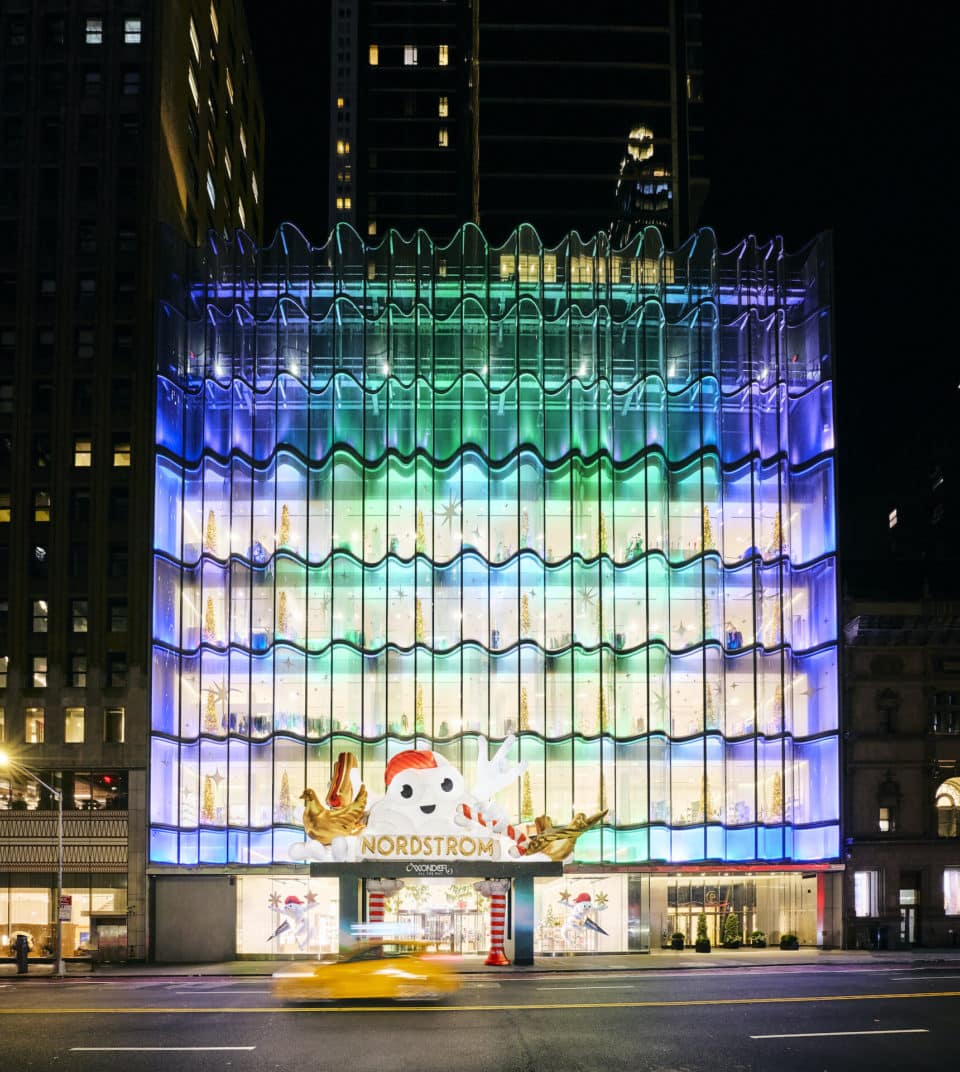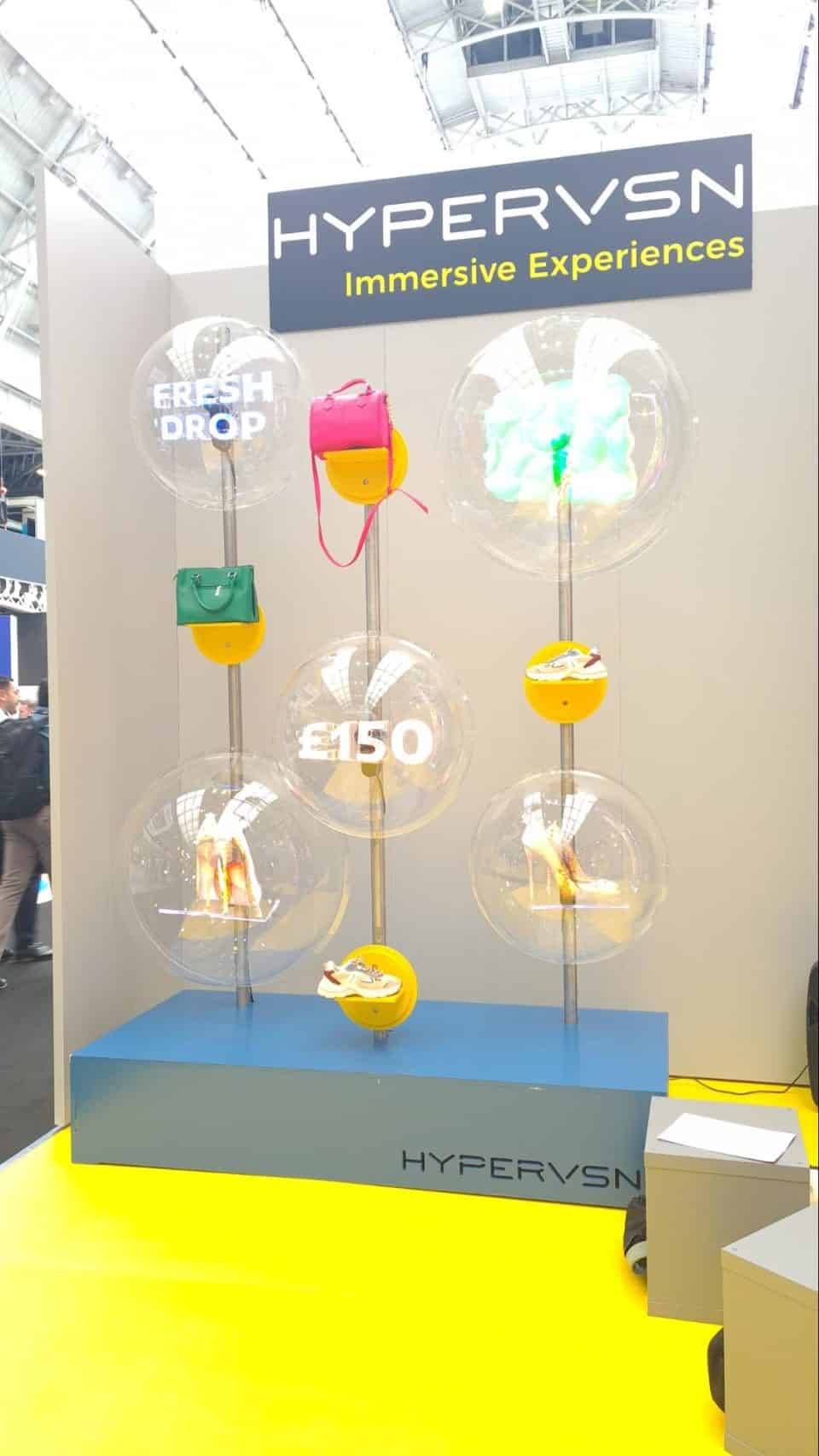Vending machines that think for themselves? Hivery on data-driven decision making in retail
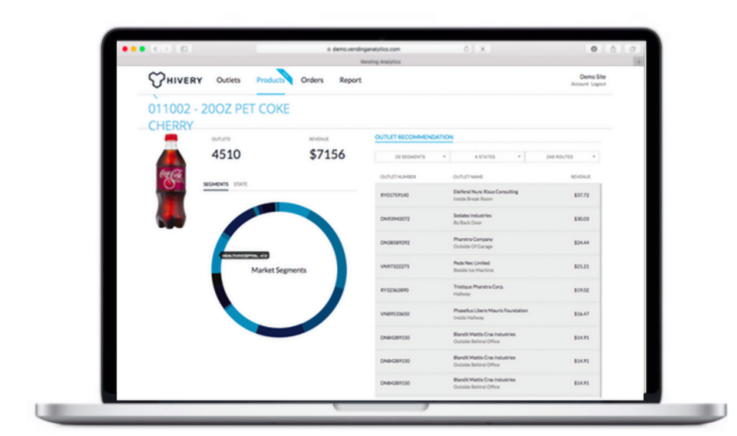
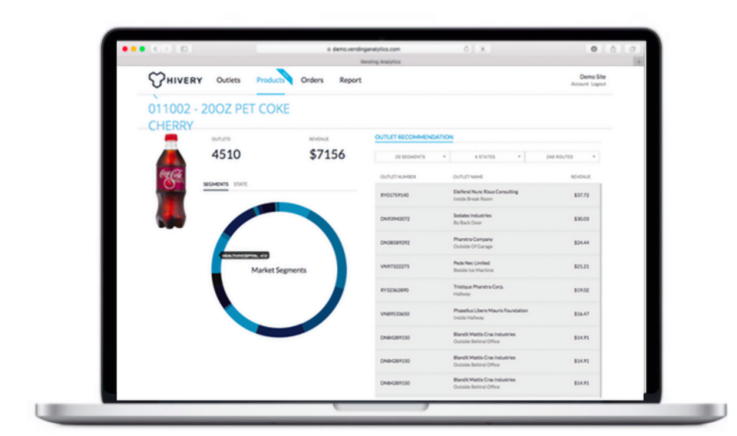
Hivery is all about data. The company lives by the motto ‘Data has a better idea’. The Coca-Cola backed company uses artificial intelligence and data to optimise the product offering in a specific vending machine, store or pop-up. It’s all about the products that will sell in that location, even if they’re all different.
With clients seeing up to 15% increase in sales revenue and 18% reduction in restock costs, it’s proving that data might just have a better idea.
We spoke to co-founders Franki Chamaki, COO, and Jason Hosking, CEO, to find out about how retail can use data to make predictions, how science can augment gut instinct and why AI if the future:
In a nutshell, can you tell us what Hivery does in a way my grandmother would understand?
Franki – Hivery is a company that loves data and explores hidden patterns to help companies see things differently to drive new profits. We do this by bringing a new “species of thinking” which we call artificial intelligence (AI) combined with Operations Research (ie Optimisation) to help companies generate a Return on Retail Space Investment.
What makes Hivery unique, besides our IP, is applying the latest in academic thinking to big challenges; we build prescriptive tools designed to recommend the best course of action. This uniqueness is emphasised through Hivery’s acquisition of novel intellectual property (IP) from the labs of Data 61 /CSIRO (a world-renowned Australian government scientific research organisation. In case you don’t know who CSIRO are, they invented WiFi).
We mostly focus on the large FMCG companies and retailers who have a lot of data, but can’t leverage it well using conventional methods and know-know. Using our AI platform, we generate humanly impossible recommendations on product assortment, space allocation, price and promotion. All actionable, all practical.
What is the relationship between Hivery and Coca-Cola? How did the company start?
Franki – Hivery was born following a big data open innovation challenge that was put on by Jason Hosking and myself. We were part of a serial entrepreneurs’ program – the Coca-Cola Founders Platform. The goal was simple: take startup thinking add Coke’s assets and create new business models. One of the assets that we were interested in exploring with Coke was data. We thought there was a lot of big data there that hadn’t been leveraged very well. Long story short, we ran a hackathon with Coke’s supply chain data and we found interesting IP, and talent: Dr. Charles Gretton, Dr. Matthew Robards, and Dr. Menkes van den Briel (i.e. data scientists with backgrounds in Artificial Intelligence and Operations Research coming from Data61/CSIRO), and from there HIVERY was created.
We started off with a simple experiment in Newcastle, just outside Sydney, looking at 60 vending machines managed by Coca-Cola Amatil (CCA) – Australia’s Coca-Cola bottling partner. The goal: to prove AI thinks differently and that we could stick vending machines better to make additional profit. After training our AI system, we gave our recommendations to CCA and asked them to execute our recommendations in market. CCA went out executed the recommended changes on the 60 machines and after few months they saw a 15% increase in sales and 18% reduction re-stock visits.
Our self-learning algorithms look at the entire vending fleet differently. They learnt the individual trading behaviors of each machine. They started seeing patterns and opportunities for a particular machine to drive better revenue through better product assortment, as well as space or price opportunities, and then recommended the optimal action to take.
Since our success within Australia, have expanded into the US and are in the pilot phase in Japan and other parts of Asia.
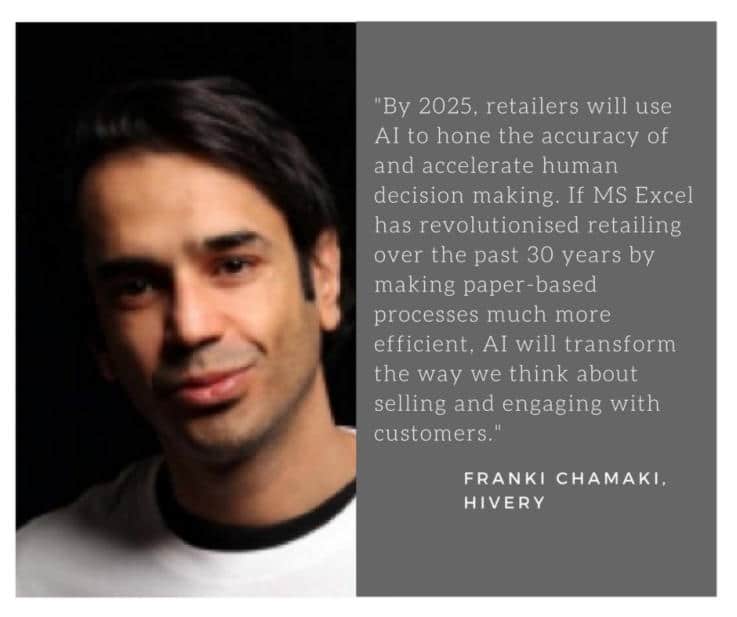
How does the system work in terms of identifying actions?
Franki – Our solution learns from the trading history and patterns of every machine in the fleet, usually many thousands. It can see what products are selling in each vending machine or physical outlet, and can understand the unique fingerprint of each machine – i.e. what is unique about it. It can then customise each vending machine or retail outlet to maximize profit – pulling the assortment lever, space lever or price lever – or some combination of the three. For users of our tool its super easy – our system displays the KPI and how it will improve based on the action you take; or to get optimal improvement, simply click ‘optimise’ – our clients simply click one button and the new recommendations are sent to the driver and they get implemented in market.
Jason – This last point is really important. Simplicity is one of the core founding pillars of our business. We focus on recruiting super talented people and developing and embracing cutting edge technology. We can have the smartest systems, intelligence and analytics sitting in the background, but if that doesn’t translate into a simple action in the retail marketplace that drives a business outcome then I feel like we’ve only done part of our job.
Number one we see ourselves as a data science company, but number two is that we are also a design company. We spend a lot of time making sure that the system and the technologies we use are so simple to use that anyone can use them and they translate into actions in the field that deliver the outcome. If you just focus on the analytics then you end up with another report or another set of insights or another visualisation tool, but it doesn’t translate into the outcome that everybody is trying to get. Converting the analytics into execution is key.
Where is the data coming from in order to make those predictions? Is it something the stores are gathering already?
Franki – That’s the beauty of it – FMCG companies and retailers have a lot of data already. Our solution simply “sits on top” of existing client systems and prescribes the actions that should be taken based on learning from that data (i.e. sales data, PoS data, transaction data, ex-factory data, etc). We don’t have to integrate web data or social media data, structured and unstructured, it’s simply using what they have today but making it smarter.
Jason – A quote that we are often citing is that 90% of the world’s data was created in the last two years. It’s quite mind-bending when you think about it. Secondly, according to a report a few years back, organisations are using about 12% of that data. So we are constantly having conversations with our customers around the fact that they have all this data, but just don’t know how to use it.
That is music to our ears. That is the type of business where we can go in and we can really make a difference quickly – because we have the smarts and the tools and the technology to transform that data into better actions for that business. Rather than being in the business of selling a solution that requires a new data stream, we’re focusing on tapping into these really rich pools of data that are already being collected but are sitting there untapped and un-utilised at the moment. We’ve got two parts of our business, the vending solution for operators of large vending fleets, Vending Analytics, and we also have the Retail Innovations business which is focused on expanding our technologies and our solutions further into the retail sphere. We are working on a number of exciting products with some very well-known partners.
Are there any other projects or developments that you’re working on?
Franki – We have a number of other products that are in the trial and development phases, but all connected to retail – Planogram analytics for specific retail spaces (such as Coolers in convenience stores) and Supermarket/Megastore shelf optimisation – product assortment, space and price optimisation. We’re doing a trial with a big retailer in Japan where we’re building the ability to optimise the shelves uniquely in each of their stores to drive incremental profits. So we can say for this shelf in this store in this particular location what is the optimal products assortment, space and price. We are also building a similar solution in the USA for a large physical retailer to do the same.
Another product that we’re building is around promotions. It’s about helping our clients identify the type of promotion to offer and when. We have developed algorithmic self-learning model, which forecasts (and optimises) promotional demand. In this model, we simultaneously analyse the impact on demand of the client’s own products SKU and those of their competitors as well as catalogue information, store product placement information and seasonality. It’s a tool that is always on, always learning, always responding to live market dynamics, to drive the best possible ROI from promotions.
How do these projects fit into your Retail Genome project?
Franki – The Retail Genome™ project is an effort to capture the essence of retail at the most fundamental level. It includes key retail characteristics like channel, brand, campaign, asset, equipment type, product assortment, packaging, geography, demography, etc. to make product, space, price and promotion recommendations that will deliver additional profit.
Everyone’s heard of the Human Genome project from 1990, which found that 22,000 genes make up a human being. Ten years later, Pandora Music also sequenced the music genome looking at 450 attributes or genes that make up a song, rather just segmenting based on just genre or artists. I might like Justin Bieber and you might like Metallica, but there’s a guitar riff in both of them that crosses over. They would never recommend Justin Bieber to you if you like Metallica, but actually you might think it’s a pretty cool song, and vice-versa. This is want we are doing but for the retail space. Not only we can recommend a specific product (i.e. Cherry Coke) but a specific Cherry Coke package: 8 fl oz. glass bottle!
We want to build this Retail Genome™ that identifies these SKU attributes that make a recommendation beyond just segmentations of brand or genre like milk, juice, soda or water.
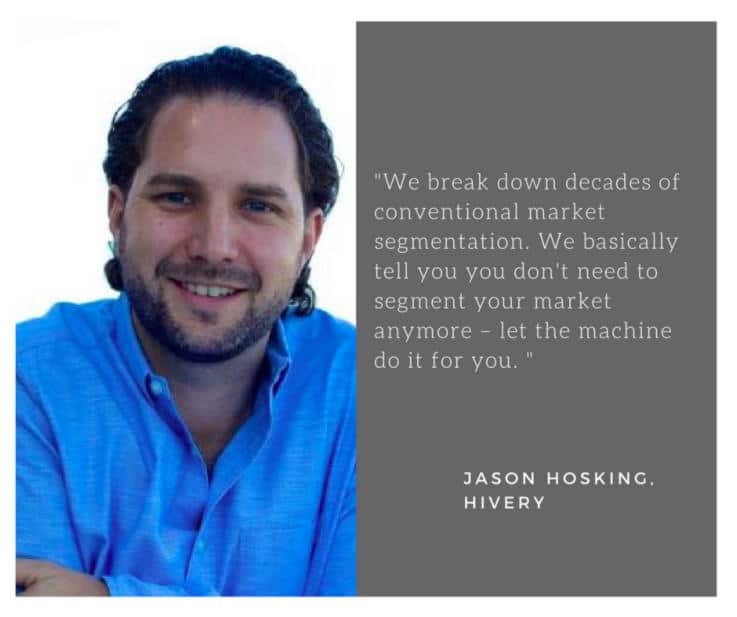
Are you finding that the recommendations from your technology disprove any tried-and-tested thinking in retail?
Franki – In every client engagement, we use a Discovery->Experiment->Deployment engagement framework. During the initial Discovery phase, it’s all about understanding. We often visit the client and learn about their problems, important KPIs and data sets and in the Experiment, it’s about training and developing our self-learning algorithms look at the client’s problem differently. In the Experiment phase it’s all about demonstrating the value the solution can deliver.
For example, in one experiment, we made recommendations for two vending machines – one in a school and one in an office that was counterintuitive and against business rules because our recommendation for the school was similar to an office, meaning that the product assortment was similar. According to our client they have strict guidelines in terms of what should be placed in a geographical area or market segment. In this case we recommended that a beverage assortment that would contravene the client’s rules in schools. So we physically went to the school and asked them to take us to the machine’s location and it turns out it was in the teacher’s lounge – the system was right. It was nothing to do with it being a school really. But from a human perspective, teacher’s lounges are treated like schools.
Jason – We break down decades of conventional market segmentation. We basically tell you you don’t need to segment your market anymore – let the machine do it for you.
Our tagline is ‘Data Has A Better Idea™’. It wasn’t that long ago that you picked up the newspaper and read that a machine was able to beat a human at chess for the first time. AI is able to diagnose all forms of diseases and ailments far more effectively and far more efficiently than human practitioners. So why is it beyond us to comprehend that with data a machine can segment the market better than we’ve always been able to?
Every time we’re dealing with a vending machine or a big supermarket chain or a massive discounter or a convenience store, we go in and we say ‘our machine is telling you that in this store there is an action to guide more profit.’ Our customers always come back to us and they say why is it saying that, is it because there is a certain ethno or socio-economic mix in that post code or is it because that’s in a hospital instead of an office tower? It micro segments and identifies trends that are actually beyond comprehension.
Another example is that we were in Las Vegas doing a vending machine pilot and our recommendation said on level 17 at the Mirage Hotel put Core Power into the vending machine, and will sell six units a day. Core Power is a protein drink, so our client said there’s no way that is going to sell, it’s a Las Vegas hotel – tell us why. And we couldn’t say it was because there was a bodybuilder’s convention on or anything. It was just the data telling us that on the 17th floor, and not any other floor, that this product will sell. So they put it in and we went back the next day and five units had sold.
There’s this philosophical debate that endures in the retail world against standardisation versus personalisation. For decades, whether it’s a vending machine or a set of convenience stores or any of the examples of the retail space, large operators say we want to standardise things, so our staff, our operations people, our sales people just know what to do.
They often respond that if they didn’t take this approach, then it would result in mayhem. With modern technologies and modern tools we can tell you what to do in each one of those stores for maximum profitability based on that store. All you need to do is give that to the staff to go and do it. This breaking down of barriers to start thinking that every outlet should be different is a big leap, because it often goes against decades of thinking.
Do you see science and analytics displacing gut instinct and human decision-making in retail?
Franki – We don’t see science and analytics displacing gut instinct, rather augmenting it. It’s like using Google Maps vs paper-based maps. Paper-based maps require a lot of human thinking (ie work out the path to take, assess traffic, reviewing the map consistently as you go, course correcting along the way). Google Maps you simply tell it where you are and where you would like to go, and it prescribes the optimum path to take as it also incorporates such things as traffic conditions and any constraints you may add such as avoiding tolls. With audio and visual cues, it guides you safely to your destination. This is what we do at Hivery with our customers. We guide our customers to their destination (additional profits, increased sales, lower cost) by suggesting actions to take.
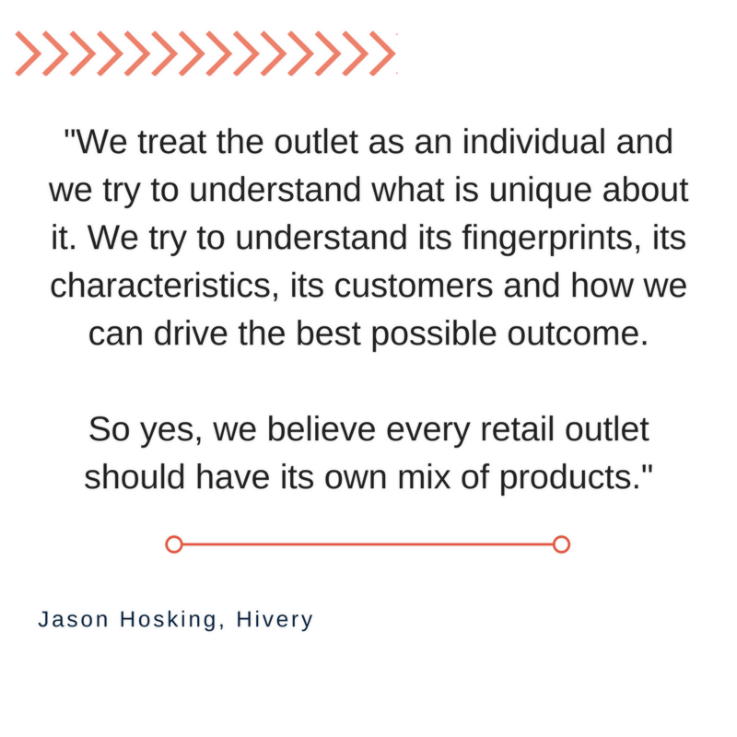
Do you think in the future every retail outlet might have a different mix of products?
Jason – What does a retail distribution point have? It has a finite amount of space – there’s a limit to what it can stock and put on display in that store and have inventory to sell to the customers. Usually depending on the category, it has a far greater number of products in its broader inventory than it can actually stock in the store. So, how do you make decisions about what goes into the outlet or into the distribution point? And if you’ve got many distribution points how can you understand the differences between each of them to drive maximum outcome out of each point?
That in a nutshell is what we do. We look at it as a great big map with all these distribution points and all these sales and all these people interfacing with it, and we’re able to extrapolate that into a system that can pull out the patterns and identify the products to sell, where and what quantities and at what price points. We’re even able to tell these big companies what is the price elasticity for every different SKU at each different location and therefore how customers might react to price changes at outlet one versus outlet two and what’s the best price strategy within that.
We treat the outlet as an individual and we try to understand what is unique about it. We try to understand its fingerprints, its characteristics, its customers and how we can drive the best possible outcome.
So yes, we believe every retail outlet should have its own mix of products.
How prevalent do you think AI will be by 2025? Will we reach a point where every retailer is using it?
Franki – By 2025, retailers will use AI to hone the accuracy of and accelerate human decision making. If MS Excel has revolutionised retailing over the past 30 years by making paper-based processes much more efficient, AI will transform the way we think about selling and engaging with customers. It provides a new dimension to our cognitive abilities.
A Harley Davidson dealer in New York found his sales leads increased by a whopping 2,930% when he used an AI-driven marketing tool. Campbell Soup use Watson Ads using weather.com to consider weather, time of day, even ingredients on hand to serve up a unique personalised recipe to customers. AI can be combined with other technologies such as Augmented Reality to allow people to say have a fashion parade in their living room with all the models being themselves and fashion experts like Kate Spade, Ralph Lauren or Marc Jacobs advising you using voice-based chat-bot style interactions with fashion experts. Retailers who do not leverage this new species of thinking will end up losing market share due to poor customer experience.
Don’t miss the unknown technologies that retail needs to be aware of, plus find out what the next phase of retail’s tech innovations are.
Want to go straight to the hottest retail technologies, latest disruptive thinking and simplest new ways to lower costs and boost sales? Transform your team’s thinking using Insider Trends’ little black book. Find out how here.

